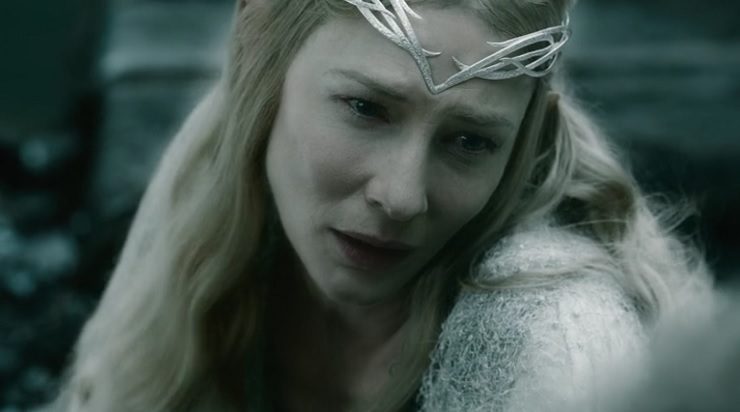She was warned—that leaving Valinor would mean exile.
She was given an explanation—indeed, it was made clear to all the Elves that following the vindictive Elf, Fëanor, boded poorly.
Nevertheless, she persisted—for Galadriel, “the only woman of the Noldor to stand that day tall and valiant among the contending princes, was eager to be gone.”
Casual moviegoers might think of her first as that blond Elf lady who bestows kisses on hobbits and gifts to the heroes. Or maybe as that white-clad, stare-eyed woman who wigs out on Elijah Wood and gets all deep-voiced and creepy. But readers know that Galadriel is so, so much more, especially those who have read beyond the trilogy.
The Lord of the Rings is so jam-packed with heroes and larger-than-life characters it’s easy to overlook those we don’t see hunting Orcs and stabbing spiders; those who just seem to stand around, give counsel, dispense wisdom, and hand out magic items like MMO quest rewards. And yet a closer look reveals how pivotal some of these characters are in the foundations of the story—especially the Elves, who are the holdouts of their race in the Third Age.
Right now I look to the Lady of the Golden Wood, who is straight-up called “the mightiest and fairest of all the Elves that remained in Middle-earth” during the events of The Lord of the Rings. Certainly she is the most ancient female… unless there really are some Entwives still lurking somewhere out there. So let’s look at what we know about her, chronologically.
I’ll start by pointing out that while The Silmarillion forms the basis of Galadriel’s role in the grand scheme of Middle-earth, I also primarily reference “The History of Galadriel and Celeborn” chapter from Unfinished Tales—a book of not-quite-finished notes and essays compiled and contextualized by Christopher Tolkien. Tales may not be strictly canon, as the writings were still unfinished at the time of the professor’s death, but it’s obvious they provide much of the lore, and of Tolkien’s intentions, behind some of his chief characters and events. Moreover, some of the writings therein were written later in Tolkien’s life and might well have been completed if he’d had the time.
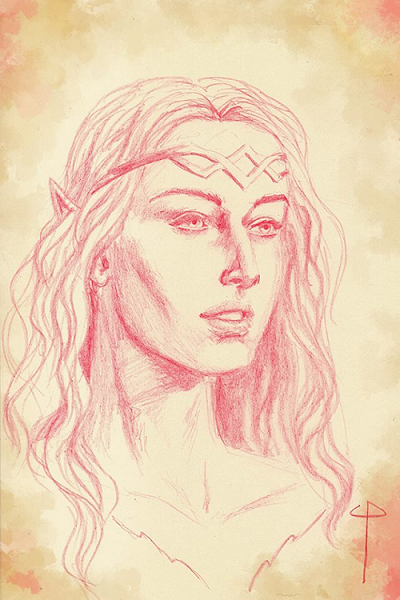
Everyone gets by now that Galadriel’s hair is luminous and golden, right? Funny thing is, even at her first mention in The Silmarillion, her locks are immediately noteworthy, “lit with gold as though [they] had caught in a mesh the radiance of the Laurelin.” Laurelin, you see, is the name given to one of the Two Trees of Valinor, a source of holy light in the early days of the world and which, by the way, precede the existence of the Sun itself. As do most of the Elves in these early years.
These same golden tresses would, many thousands of years later, assist in smiting the heart of Gimli, the stout-hearted son of Glóin. And lest you think beauty or descriptions of hair are unique to women in Tolkien’s works, we learn in Unfinished Tales that these aureate locks Galadriel inherited mostly from her father and his mother. Hair—its color, its length, its radiance—is an oft-mentioned feature in Tolkien’s works, and is commonly mentioned in high-born, noble-hearted, or powerful beings, be they male or female. Witness the hair of the Maia named Uinen, the Lady of the Seas, which “lies spread through all waters under sky,” the “grey silver” of King Thingol’s head, or the prince Fingon, who “wore his long dark hair in great plaits braided with gold.”
Anyway, so lovely are Galadriel’s locks that, as is speculated in Unfinished Tales, the way they shone inspires in her half-uncle Fëanor—indisputably the most infamous of Elves—the very idea of “imprisoning and blending” the light of the Two Trees. And he does this, on spec, by crafting the woundrous Silmarils—presumably with “kind of like how Galadriel’s hair does” penciled into the margins of his gem-crafting blueprints. Now, the Silmarils, and especially the decisions Fëanor sets in motion around their fate, have a mighty rippling effect upon all of Middle-earth’s history to come. So one could argue that Galadriel, with a mere turn of her lovely head, was a contributing catalyst to much that followed.
Of this, in Unfinished Tales, Tolkien wrote:
For Fëanor beheld the hair of Galadriel with wonder and delight. He begged three times for a tress, but Galadriel would not give him even one hair. These two kinsfolk, the greatest of the Eldar of Valinor, were unfriends forever.

Aside from being a delightful snub of the arrogant Fëanor, this passage—which I sure wish Christopher Tolkien had included in The Silmarillion—further emphasizes Galadriel’s esteem for Gimli in The Fellowship of the Ring. And therefore ours, because Gimli is awesome.
All right, so she’s a groovy lady, and a striking one at that. But she is not just a pretty head of hair. Who is she and what makes her lineage and her hair worthy of discussion at all? What’s her origin story?
From the first, Galadriel is true royalty. Her father is Finarfin, son of the High King of the Noldor. The Noldor are the second great clan of Elves who journeyed westward to Valinor when the Elves were summoned there after their “awakening” in the world. Galadriel’s mother is Eärwen, daughter of the king of the Teleri. The Teleri are Sea-elves, those who lingered on the shores of Valinor and took to ship-building and, I assume, whale watching. After the very tragic event known as the Kinslaying—a travesty instigated by the aforementioned Fëanor—Galadriel’s father returns to the Blessed Realm of Valinor and becomes the High King of his people. She is therefore a princess by association and the youngest of four (and the only girl).
So Galadriel is in lofty company from the start and bears witness to many of these early events that shape the history of Middle-earth. She is a leader among the Noldor when the Elves are still young as a race and still dwell in the company of the Valar. The Valar are the god-like entities who serve as the shapers and overseers of the world, as designed by Ilúvatar. They are not the ones who created Elves or Men—Ilúvatar alone, as supreme deity, has that claim—but are given authority to watch over, judge, and advise his Children (Elves are the Firstborn and Men, when they show up, are the Secondborn).
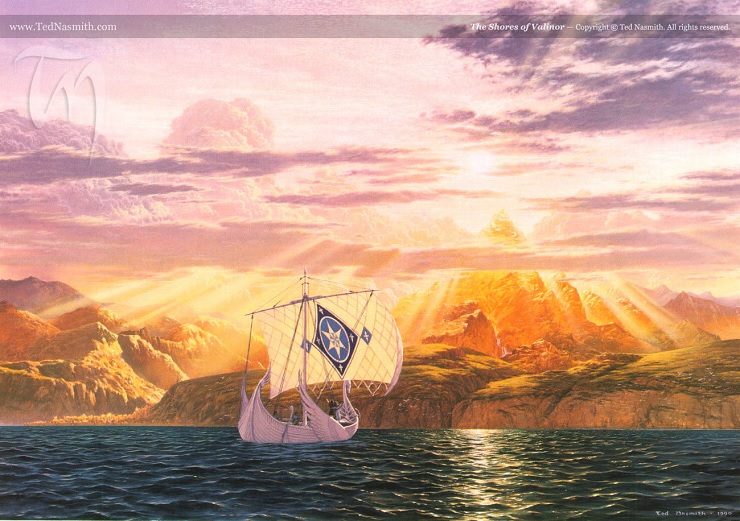
Galadriel is also one who has lived amid the light of the Two Trees of Valinor, and that sets her apart from almost everyone in the The Lord of the Rings thousands of years later. If you’ve not read The Silmarillion, know that this is an important point. See, there are various ways to classify the Elves, but one particularly unique and big-picture method Tolkien devised is this: which Elves saw the light of the Trees of Valinor and which did not? First, understand that Valinor is the Blessed Realm, or the Undying Lands, the dwelling place of the Valar and the seemingly mythic realm where ships later sail to “into the West” when leaving Middle-earth. But in these early years, you could go to Valinor physically; it was a place on a map, a whole continent, and if you had the permission of the Valar—as all Elves did—then voilà, you were in!
But after some very cataclysmic and tragic events, which are orchestrated foremost by the fallen Vala named Melkor (aka, Morgoth, the whole world’s Public Enemy No. 1), Valinor later becomes a place utterly inaccessible to anyone without the express involvement of the Valar.
So if you are an Elf who has seen those two gigantic Trees with your own eyes, great, you’re of the Calaquendi—the “Elves of the Light.” If you are not so lucky, then you are of the Moriquendi—the “Elves of the Darkness” never graced with that light—and that actually means you are of lesser might. This distinction means little in terms of one’s character, of any intrinsic good or evil, but relates more to one’s grace and a memory of that hallowed place.
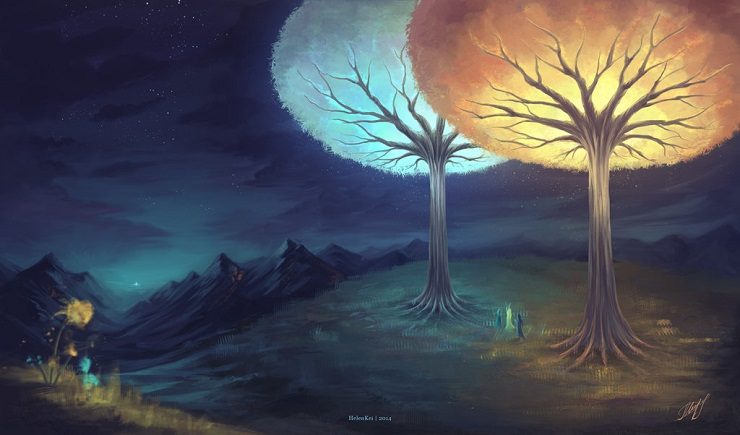
Galadriel is very much Calaquendi, and all the way through the First, Second, and Third Age, her powers exhibit this distinction, and then some. By comparison, much younger Elves like Legolas and even Elrond—who are born long after the sad demise of the Two Trees—are, by default, Dark Elves. Galadriel isn’t the only Calaquendë still in Middle-earth by the War of the Ring, but she is one of only a few.
Recall Glorfindel from The Fellowship of the Ring, the Elf who meets our heroes, post-Nazgûl-stabbing, on their way to Rivendell. When Frodo awakens later and talks with Gandalf about what happened at the Ford of Bruinen, the wizard says, concerning Sauron:
‘And here in Rivendell there live still some of his chief foes: the Elven-wise, lords of the Eldar from beyond the furthest seas. They do not fear the Ringwraiths, for those who have dwelt in the Blessed Realm live at once in both worlds, and against both the Seen and the Unseen they have great power.’
Frodo recalls seeing “a shining figure of white light” when the Ringwraiths had advanced on him, before he blacked out from his Morgul-wound.
‘I thought that I saw a white figure that shone and did not grow dim like the others. Was that Glorfindel then?’
‘Yes, you saw him for a moment as he is upon the other side: one of the mighty of the Firstborn. He is an Elf-lord of a house of princes. Indeed there is a power in Rivendell to withstand the might of Mordor, for a while: and elsewhere other powers still dwell.’
Gandalf doesn’t say it here, but those “other powers” refer to those like Galadriel—and probably the Lady of Lothlórien most specifically.

But still, that is all much, much later. I only wish to stress what it implies to be counted among “the mighty of the Firstborn.” In RPG terms—because I can’t fully turn off that part of my brain—let’s just say that the early Silmarillion Calaquendi had a lot more hit points, some insane skill bonuses, and possibly a handful of unique powers we don’t see in latter-day Elves. Unfinished Tales calls out Galadriel’s talent directly, which we certainly see play out in Fellowship:
From her earliest years she had a marvellous gift of insight into the minds of others, but judged them with mercy and understanding, and she withheld her goodwill from none save only Fëanor.
And yeah, there’s another fun jab at Fëanor. I won’t go into him too much here, but suffice to say that he’s like the Elven version of Morgoth: proud, jealous, wrathful, a great instigator of terrible deeds, and yet all encapsulated in a genius mind whose creative skills outmatch those of his peers. It was he who crafted the three Silmarils and captured in them some of the light of the Trees of Valinor. Three gems of utmost beauty and wonder, they are highly coveted and lead to drama and doom for everyone roped into their fate. But after the Trees’ are withered by the doings of Morgoth, their light is extinguished, and Valinor (and to some extent, the whole world) is darkened. The Valar ask Fëanor if he will allow the Trees to be rekindled with the Silmarils’ light, but he refuses out of jealousy and spite, and the Valar do not press the point. Free will is important to them—and was to Tolkien.
When Morgoth eventually slays (spoiler alert!) the High King of the Noldor, who is both Fëanor’s father and Galadriel’s grandfather (through different parentage), then steals the Silmarils and flees to Middle-earth, Fëanor blames the Valar for everything as a petulant child might blame a parent for his own poor decisions. Yet he is charismatic and confident, and he manages to rally the Elves together and convince most of them to follow him out of Valinor altogether—beyond the protection and influence of the Valar, who Fëanor casts in a sinister and domineering light. Taken aback, the Valar are initially silent about this.
Although many are on board with Fëanor’s plan, they aren’t all in agreement that he should be the king to replace his father (there are two other sons, one of whom is Galadriel’s dad). Remember, Galadriel is essentially president of the Fëanor Sucks Club; the two are unfriends. But, she is swayed by his goal to go to Middle-earth and oppose Morgoth, if not his methods or his leadership. She is young and proud herself, nursing ambitions of her own. She was “eager to be gone,” and furthermore:
No oaths she swore, but the words of Fëanor concerning Middle-earth had kindled in her heart, for she yearned to see the wide unguarded lands and to rule there a realm at her own will.
Kindness is in her heart, and even “a reverence for the Valar that she could not forget,” but it is not enough to ground her there. When the Valar send forth a herald to bid the Noldor not depart, Fëanor hand-waves it away and the Elves continue on. No matter her thoughts, Galadriel is complicit in rebellion, in the rejection of authority. As a much younger Elf, she is like a highly educated heiress who believes herself destined for great things, a restless princess eager to be queen who will not be held back. So as posited in Unfinished Tales, “once she had set foot upon that road of exile she would not relent, but rejected the last message of the Valar, and came under the Doom of Mandos.”

The Doom of Mandos, aka the Prophecy of the North, is the final warning the Valar issue, and it comes on the heels of a great evil enacted by the increasingly erratic and rabble-rousing Fëanor. See, at the head of this Elven exodus, Fëanor and his biggest supporters engage in the Kinslaying at Alqualondë, a port city at the edge of Valinor where a different group of Elves dwell: the sea-loving, ship-building Teleri, who otherwise had no part in all this rebel talk, and who just happen to be Galadriel’s mom’s people! Fëanor slays those Elves of the Teleri who try to prevent his posse from taking their ships—ships he intends to use to get the hell out of Dodge (i.e. Valinor.) This is the Elves’ Cain-and-Abel moment, when Elf blood is spilled by Elf for the first time.
In another account of Galadriel’s history, Tolkien even suggests that she fought back (presumably with her brothers) against Fëanor in that battle. Somehow. (I desperately wish he’d said more—she bore weapons?!) The Silmarillion doesn’t offer great detail about the Kinslaying—only heartbreakingly beautiful prose, per its usual M.O.—and only later intimates that Galadriel and her brothers had no part in that bloody event. Yet even the death of her mother’s kin isn’t enough to turn her back to Valinor after the Doom of Mandos gives every Noldo a final warning to do so. In fact, Galadriel is driven by her contempt for Fëanor and follows him on to Middle-earth “to thwart him in all ways that she could.”
Fascinatingly, there is yet another version of Galadriel’s departure from Valinor that is less compatible with the others, but it is also, according to Christopher Tolkien, the “last writing of my father’s on the subject of Galadriel and Celeborn, and probably the last on Middle-earth and Valinor, set down in the last month of his life.” (Which…whoa.) He even talks about this in one of his now-published letters. In this version, Galadriel meets her future husband in Alqualondë, pre-Kinslaying, and makes plans with him to leave Valinor well before Fëanor and the other Noldor. She greatly desires to bring what she’d learned from the Valar to Middle-earth “for the exercise of her talents.” And it is obvious she is a top-notch, Hermione-level student who always did her homework. As is suggested but never explicitly stated in more canon texts, Galadriel is basically bursting at the seams with power and lore, and possesses a “commanding stature” that is nearly the equal of Fëanor’s. This account emphasizes a stronger opposition to him specifically, as though Fëanor and Galadriel are two sides of the same Elf coin.
In Silmarillion canon, however, Galadriel departs with her brothers in their own company, well behind Fëanor, joining the host of her uncle, Fingolfin. When they are abandoned by Fëanor even after the savagery of the Kinslaying, they are forced to journey through the brutal wastes of the Helcaraxë, the Grinding Ice, the frozen land-bridge in the far north that then connected Valinor with Middle-earth. “Few of the deeds of the Noldor thereafter surpassed that desperate crossing in hardihood or woe,” Tolkien wrote, and many Elves perish in the journey. It’s just this sort of context I like to consider when I read about the Fellowship’s sojourn in Lothlórien. We’re used to picturing her barefoot in star-lit forest glades, clad in simple white, and at one with the natural world. But she is one who has endured the “terrors of the Helcaraxë,” too, and seen kinsmen slain by treachery and bitter cold. Add all of this to her résumé of badassery.
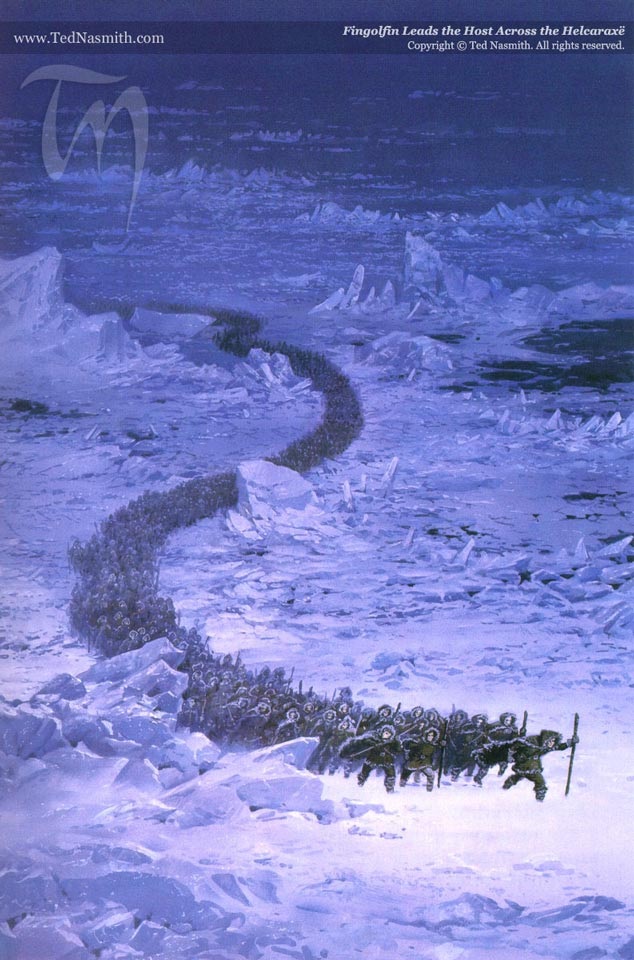
In any case, Galadriel plays little or no part directly in the larger conflicts in which the Noldor take part after they reach the shores of Middle-earth, where they mingle with various groups of Dark-Elves, battle Morgoth’s minions, and establish kingdoms throughout the region called Beleriand. She herself settles into the lush and forested realm of Doriath, which is ruled by King Thingol and Queen Melian.
Melian herself is a big deal, and the fact that she and Galadriel become friends is no small thing. For one, Melian is a Maia, one of the powerful spirits set forth to help shape the world, of the same order of beings as Sauron, the Balrogs, and the wizards-to-come like Gandalf and Saruman. And as far as I can tell, she is the only one who not only chooses to dwell on Middle-earth among the Elves but also married one. Sure, Thingol is a king of no small stature (hell, he’s called out as being the tallest of the Children of Ilúvatar) but he’s still an Elf, not a demigod powerful enough to conjure “an unseen wall of shadow and bewilderment” that keeps out of the kingdom everyone and everything without her permission, or her husband’s. Which Melian totally does to fence in Doriath from Morgoth’s reach. As the hosts of the meritorious Prancing Pony Podcast have pointed out a few times, quite a lot of the males in Middle-earth sure do marry up!

So Galadriel and Melian become BFFs. One is a queen, the other still clearly wants to be (but to her credit, she is patient about it), and through her friendship with the elder Maia Galadriel sharpens her already impressive powers—many of which she will one day employ in the glory and protection of Lothlórien. Not to mention that we learn that Melian is the first maker of lembas bread—guess we know where Galadriel gets the recipe! They seem like sisters, sharing old stories of Valinor “and the bliss of old” in a land where few can relate, but Melian is at least as insightful as her friend and sees that she is haunted by some grief. For none of the exiled Noldor, not even the good-hearted Galadriel, have admitted up to this point to the other Elves why they left Valinor and under what circumstances.
Melian asks Galadriel why she does not speak of it.
‘For that woe is past,’ said Galadriel; ‘and I would take what joy is here left, untroubled by memory. And maybe there is woe yet to come, though still hope may seem bright.’
Galadriel’s maturity is showing. She is less proud, and not quick to point fingers. Gone is her earlier, Morgoth-may-care self. It may in part be because one of her early motivators has been removed; by this time, Fëanor has already been slain. She is adrift, living apart from her brothers, possibly unsure of her path ahead. Her time to take charge and lead has not yet come, though her wisdom increases. In this conversation with Melian, she dares not lie about the past, but she also cannot face the full guilt of her kin. She says that the Noldor left of their own choosing and were not cast out (true, though having left they have become exiled, per the Doom of Mandos), but she leaves out the part about…well, the Elves-killing-other-Elves thing. That comes to light soon enough, and not by her. She has more learning to do.
It is in Doriath that Galadriel at last meets and falls in love with Celeborn, a prince and kinsman of Thingol’s. He’s also, mind you, one of the never-saw-the-light-of-those-Trees Moriquendi, And as time goes by, Galadriel is surrounded more and more by Elves who never knew the bliss of Valinor as she had. At some point, the two marry, and but for one Firstborn king who got special permission, all Elves marry only once.

As mentioned earlier, Galadriel never joins any of the great battles of the First Age, even peripherally, against Morgoth. As times goes by, her wisdom increases, and she takes a longer view. She sees no point in rushing against Morgoth directly, as so many of the Noldor do, wdriven too much by vengeance. I am left wondering if she was more active in arguing against their folly; Tolkien didn’t say. The Elves of this era are still strong, but they are not Maiar, nor Valar (as even Morgoth himself was once counted). Remember, also, that Galadriel has greater respect for the Valar than do most of the exiled Noldor. Unfinished Tales even clarifies this point about her and Celeborn:
In the years after they did not join in the war against Angband, which they judged to be hopeless under the ban of the Valar and without their aid; and their counsel was to withdraw from Beleriand and to build up a power to the eastward (whence they feared that Morgoth would draw reinforcement), befriending and teaching the Dark Elves and Men of those regions.
Like Galadriel herself, Celeborn’s role as a leader and adversary to Morgoth’s servants comes much later. It is enough to say that Galadriel found and married her husband in the First Age, before the final defeat of Morgoth, the rise of his ambitious lieutenant, and the destruction of all of Beleriand. It’s like they always say: the couple who gives counsel against Morgoth together stays together.
Meanwhile, although not yet a queen of any realm, Galadriel is very much a sister to her brothers. She is most in character like Finrod, the eldest brother, and at one point she visits him in his own kingdom, where he has become a king. Meddling in the way a sister sometimes ought to, she asks him why he has not married. Surely he could find a nice girl in his kingdom, Noldor or otherwise! But ahh, sadly, Finrod is as prescient as his little sis, and he replies that he needs to remain “free” to fulfill an oath of his own yet to come—not of marriage, but of something grim and purposeful.
And indeed, of the children of Eärwen and Finarfin, only Galadriel survives beyond the First Age. Two of her brothers are slain in the Battle of Sudden Flame, a massive conflict wherein Morgoth burst from his stronghold of Angband after having been contained there for quite some time. With his homegrown and monstrous legions, he first turns an empty plain into a wasteland of fire and poisonous vapors, and the Elves and Men who stand against him suffer heavy losses. Including the notable fall of the High King of the Noldor (and Galadriel’s uncle), Fingolfin, in hand-to-hand combat with Morgoth. Her eldest brother, Finrod, does survive this war by the intervention of some particularly intrepid mortal Men. For their loyalty, he swears an oath of friendship to them. Sadly, it is this oath—plus Finrod’s tendency to be a paragon of awesomeness and friendship—that later ropes him into the quest of the famous Beren (of Beren and Lúthien fame). In that epic tale, Finrod meets his end at the hands of Sauron’ werewolves (but not until after having a grand sing-off against the future Dark Lord of Mordor and after saving Beren with his literal bare hands).
Aside: If you’ve never read The Silmarillion or thought it’s just a bunch of flowery words about Elves, think again. It’s also full of magic dogs and maimings and Orcs and shade-throwing talking dragons and stuff.
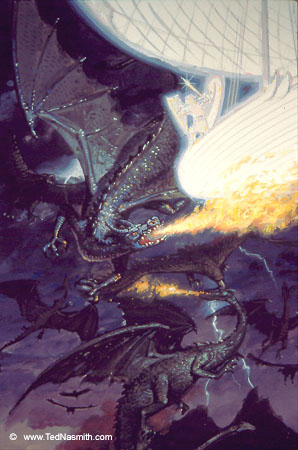
So, while Galadriel takes no part in these wars, she is obviously grieved by them, having lost her brothers and many kin. Ushering in the final days of the First Age, the War of Wrath then sees the Valar finally come forth from the West—by fantastical means—to lead the charge against the Dark Enemy of the World. Few of the Middle-earth-dwelling Elves actually take part in this, either; it is the Valar and many Elves who had remained faithful to them in Valinor who comprise this army, along with Eagles, Maiar, and one flying ship! They clash with Morgoth’s full might, his Orcs, Balrogs, dragons, and everything else at his disposal.
In the most epic of epic battles, the armies of Morgoth are destroyed, and the Vala formerly known as Melkor is carried away in chains, then thrust out into the Timeless Void. Which is a place only the Valar are capable of ousting someone, and probably sucks real bad (as surely the brochures indicate). During and after the course of the War of Wrath, this corner of Middle-earth is so badly damaged that most of it ends up sinking down into the earth and is swallowed up by the waves. Only the easternmost region, which becomes the Elf-occupied realm of Lindon, remains of what used to be Beleriand.
Here, then, is an important moment for all the Noldor, and for Galadriel especially. After hundreds of years, the Doom of Mandos is lifted: for their often vain if valiant efforts against Morgoth, all the Noldor (except for the remaining sons of Fëanor) are pardoned. Their early rebellion and departure is forgiven, the ban on their return to Valinor is lifted. And most of them, weary of war and of the world, do indeed go westward back to the Blessed Realm where their hearts will no longer be troubled.
Some of the Noldor choose to remain, though not many, and Galadriel is called out as one of the notables. She and Celeborn still take the long view, or as she will tell Frodo someday, “together through the ages of the world we have fought the long defeat.” For though Morgoth is removed from the picture, his evil endures. And in not so long a time, Sauron himself will eventually assume the mantle of Dark Lord and it is under his banner that those evils take shape. While The Silmarillion merely states that Galadriel “alone remained of those who had led the Noldor to exile,” in nearly every other account, from Unfinished Tales to Tolkien’s own letters, it’s said that Galadriel outright refuses the pardon granted by the Valar. She is no Fëanor, but after all these centuries, she is still not without pride and still set on ruling a realm of her own.
But frankly, my impression is that although pride and ambition sent Galadriel out of Valinor in the first place, her maturity and a desire to keep fighting the good fight keeps her there. She may not have been counted as a great warrior, taking on Balrogs and dragons as did her kinsmen, but I would argue that she, above all Elves, is closest to the counsels of the Valar; she learned much from their wisdom in Valinor, then she hung with a Maia and actually listened to her—when we see time and again that Melian’s own husband, Thingol, seldom did. Galadriel’s long history does indeed sound like the fostering of a queen, not a soldier.
Sauron, too, is actually given a chance to return and face his judgement before the Valar. Yet deep shame and fear of an unknowable sentence causes him to double down instead, retreating into the depths of Middle-earth, where he falls back into his comfortable Morgoth-nurtured self.
And not coincidentally, it is in this Second Age that Galadriel’s leadership flourishes. First, she and Celeborn linger in Lindon, where she hangs out with the much younger Gil-Galad (last High King of the Noldor) and a chap named Elrond Half-Elven; then, they drift eastward and kickstart a Noldorin realm west of the Misty Mountains. Here they are appointed as Lord and Lady, and at her prompting, establish diplomatic ties with their mountain-dwelling neighbors: the Dwarves of Khazad-dûm! These were the happier times when you could, y’know, just speak “friend” and enter a place.
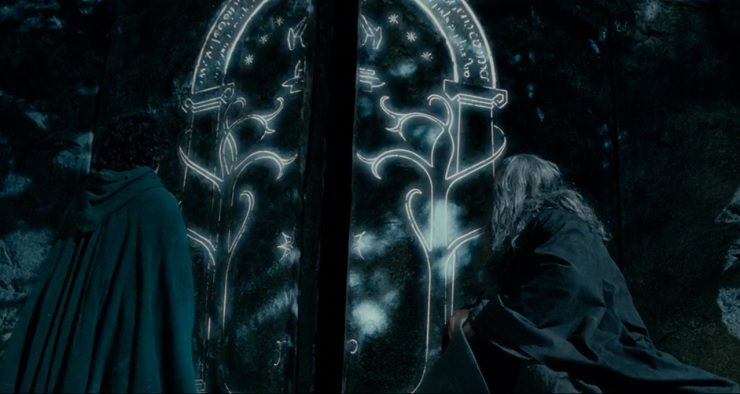
But it isn’t just trade with the Dwarves that brought her there. Galadriel alone “perceived that there was an evil controlling purpose abroad in the world,” despite the long peace that followed Morgoth’s removal. She has a special brand of sixth sense and ideas about what to do about it. Now Celeborn isn’t as pleased to be mingling with the Dwarves for some very personal reasons. In Unfinished Tales, Tolkien writes:
In any case, Galadriel was more far-sighted in this than Celeborn; and she perceived from the beginning that Middle-earth could not be saved from “the residue of evil” that Morgoth had left behind him save by a union of all the peoples who were in their way opposed to him.
First, this instantly calls to my mind the “Many Meetings” and “The Council of Elrond” from The Lord of the Rings, because ultimately it does take teamwork and, well, fellowship, to win the day. And second, how gross is the phrasing “the residue…that Morgoth left behind”? Very!
Despite this constant unease about Sauron, there are some happy times in the Second Age. Galadriel has a daughter, Celebrían (future mother of Arwen)! And another significant Noldo comes onto the scene, one who has a big part to play: Celebrimbor, who is likely the only grandson of Fëanor. He’s a kickass jewel-smith like his ill-fated grandsire, but certainly is not as nasty, and he’s also rather fond of Galadriel. But who isn’t, right?
Oh, wait, Sauron isn’t! Now he’s rebranding himself the Lord of the Earth, and starts in with his mind games. He knows the Elves are the greatest threat to his goal (you know, dominion over all Middle-earth) but he can’t yet wage war against them. He is no Morgoth, and cannot hope to hold against them all… yet. It’s not just the remnant of the Noldor he’s facing, but scads of Dark Elves who’ve long since settled in various lands. Morgoth might have been mightier, but Sauron is more subtle in his deeds. He has to be, having watched his boss get dragged off by the Lords of the West.
So Sauron plays to his time-honored strengths of skulduggery. He commits serious identity fraud by assuming the charismatic and handsome persona of Annatar, the Lord of Gifts. And everyone falls for it. Or, most do. He befriends the Noldorin Elven smiths of the day, for they possess the cutting-edge, jewelry-making technology he intends to exploit. With a disarming charm and presumably some industrial-strength Morgoth-residue-suppressing cologne, he gets in real tight with Celebrimbor. In doing so, Annatar—who totally isn’t Sauron the Deceiver in a Scooby-Doo villain mask—will ensnare them all.

Meanwhile, Sauron avoids a few particular Elves, including Galadriel, who are wary of his alter ego, but even they can’t quite see through it. In one account, he even claims to be an emissary of the Valar specifically sent to give aid to the Elves. Which he knows they crave. He also knows Galadriel is his “chief adversary and obstacle” in this, and therefore “endeavoured to placate her, bearing her scorn with outward patience and courtesy.” Not so much in hopes that she will come around, but in hopes of buying time in order to do what he intends to do.
And so, right there under Galadriel’s nose, in her own realm, this fallen-Maia-in-Elf’s-clothing starts up a secret club of Elven smiths, wherein he teaches his pupils the sinister arts-and-crafts of—you guessed it!—ringmaking. He sees that these Noldor are divided in mind and “not at peace in their hearts,” for they long for a return to Valinor, yet love Middle-earth and wish to stay. Sauron, asshole that he is, capitalizes on this heartsickness. Celebrimbor and the other smiths lose themselves in their efforts, clearly working nights and weekends as they try to fill that Valinor-shaped hole with Sauron’s ring-based schematics. In Unfinished Tales, it’s even suggested that Sauron actually persuades this secret brotherhood to revolt against their Lord and Lady, prompting the unplanned exit of Galadriel and Celeborn from their own realm. And with the meddlesome Galadriel unawares, the height of Celebrimbor’s jewelry-making is achieved. From his forge, and those of his buddies, come the Rings of Power!
Much has been written of all that follows, but in short: Sauron heads over to his new abode in Mordor in the east and starts whipping up his Master-ring to complete his plan. But the Three Rings of the Elves are actually made by Celebrimbor after Sauron’s departure and without his micromanagement, which ends up making all the difference. First, despite all the ring-making secrecy, Celebrimbor is a nice guy. In an act that his granddad would have disapproved of, he gives the Three to other people. One of them, Nenya, the Ring of Water, goes to Galadriel. Its power is great, and according to Unfinished Tales, it even makes her yearn for the sea, and the West, as if she wasn’t already keenly aware of her exile.
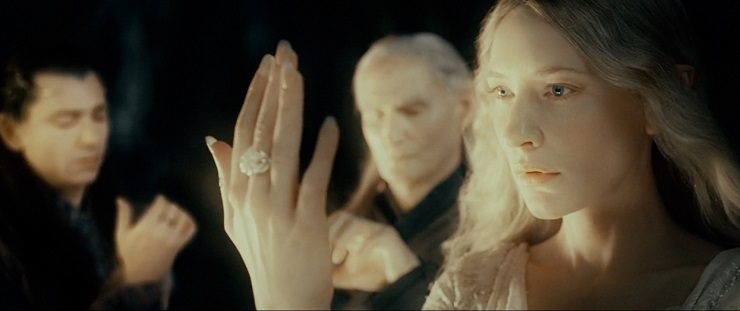
When Sauron finishes his boss ring and slips it on, his cover is totally blown, so the Elves immediately take theirs off. This enrages him, and he finally throws down the gauntlet of open war. Galadriel becomes instrumental in all counsels against him. She tells everyone to keep their rings off, hidden, and never to use them. And the fact that Sauron is never able to figure out which goddamned Elf has which goddamned ring infuriates him all the more. He can only guess as the ages go by.
A whole slew of battles occur, with victories and setbacks on all sides. Celebrimbor is captured by Sauron, tortured for as much information as can be squeezed from him (not much!), then slain and paraded about as an Orc arrow pin cushion. Sauron sends his Orcs west and almost overwhelms Elrond’s forces but his army is suddenly attacked “in the rear” by the angry Dwarves of Khazad-dûm (which is not a place you want to be attacked by Dwarves, angry or otherwise).
Galadriel forms the White Council to direct the forces of the West, and at its behest Rivendell is founded as one of the primary refuges against evil—and as we know, it is here that Elrond sets up shop. For years the struggle is a constant mess of battles between Sauron and those who stand up against him. It is in this time that Sauron uses the One Ring to corrupt (but can never master) the Dwarves , and he takes his hold over the Nine Rings given to Men. The Last Alliance is eventually formed, Isildur does his finger-choppy thing, and the Dark Lord’s ring-based pyramid scheme comes to a dramatic end.

…well, not permanently. The Second Age comes to a close, and a relative peace returns to Middle-earth. But here in the Third Age, Galadriel remains watchful. With the One Ring lost, the Three Rings of the Elves can now safely be used again. In the realm of Lothlórien—which was first established by some nope-still-haven’t-seen-those-Trees Moriquendi Elves—Galadriel and Celeborn take up residence and become its Lord and Lady. With the power of Nenya, and her own Valar- and Melian-inspired arts, Galadriel turns Lothlórien into the place we see in The Lord of the Rings: the Golden Wood with its mallorn trees that “holds evil from the land.”
Galadriel left Valinor thousands of years in the past “to rule a realm at her own will,” yet she settles for simply overseeing the final refuge of a race that has been long in decline. She had great power, desired more, and sought always to use her skills. At this point, she doesn’t even go for a royal title, even though others regard her as a queen. In Unfinished Tales, Tolkien wrote this of Galadriel and Celeborn:
There they dwelt while the Third Age lasted, but they took no title of King or Queen; for they said that they were only guardians of this small but fair realm, the last eastward outpost of the Elves.
When the wizards arrive on the western shores of Middle-earth a thousand years into the Third Age, Galadriel is one of the three who learns exactly who they are and the nature of their purpose. And of those, it is of Gandalf that she is fondest, and she perceives him rightly to be the wisest and most loyal. She even tries to convince him to lead the reformed White Council, but he declines in deference to the unquiet Saruman, though he remains an active participant. Undoubtedly Gandalf is the most active agent of Sauron’s opposition throughout the Third Age.
Galadriel and Gandalf always seem to have a special bond—this is hinted at but never explained in Jackson’s films. Even in Unfinished Tales, they share a brief but touching scene:
For the years of her exile began to lie heavy on the Lady of the Noldor, and she longed for news of her kin and for the blessed land of her birth, and yet was unwilling to forsake Middle-earth. And when Gandalf had told her many tidings she sighed, and said: ‘I grieve for Middle-earth, for leaves fall and flowers fade; and my heart yearns, remembering trees and grass that do not die. I would have these in my home.’
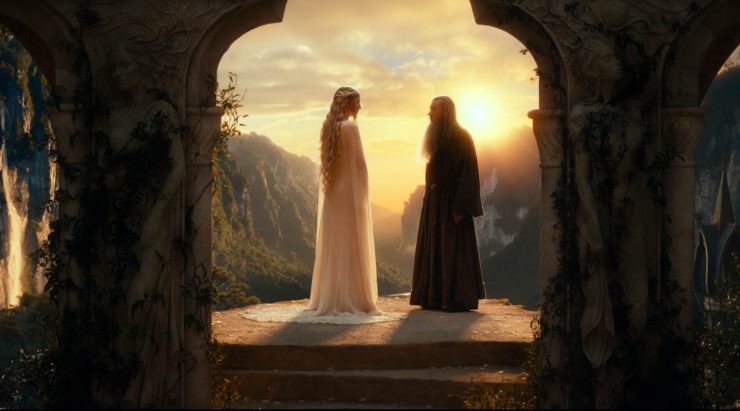
Knowing that Gandalf was sent by the Valar, that he was a Maia (as her friend Melian had been), she knows she can confide in him in ways she cannot even with her husband, who had never experienced Valinor. But Gandalf certainly has, and far more recently. In this version of events, it is even Gandalf who gives her the Elessar, the Elfstone, that is mentioned in the “Farewell to Lórien” chapter of Rings.
She in turn gives this ancient First Age treasure, long thought lost, to her daughter Celebrían. Celebrían marries Elrond fairly early in the Third Age, and the two share many years together in Rivendell. But of course evil is only sleeping. Though none have seen or heard from Sauron in a long time, his Orcs still linger unchecked in the mountains, and while journeying to visit her parents one day, Celebrían is captured and tortured by some! She is wounded with poison, and even when her sons slay the Orcs and rescue her, Elrond is only able to cure her physical body. Celebrían remains haunted by the experience and she loses all joy for the world. With no other recourse, she is forced to sail into the West, leaving Elrond without his wife, and Galadriel and Celeborn without their daughter.
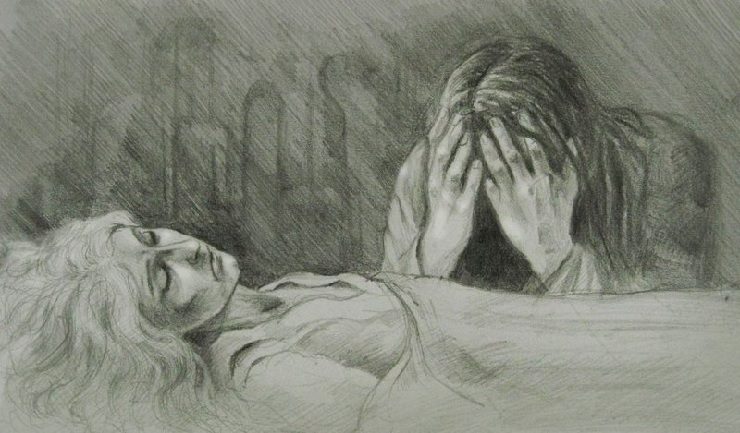
Galadriel has many good reasons to remain on Middle-earth on behalf of the Noldor, but even in his silence Sauron constantly gives her reasons to keep sending him hate mail. Fortunately, she does have the occasional opportunity to score one for Team Noldor. Some years after Gandalf discovers that the Necromancer in Dol Guldur is indeed Sauron, he convinces the White Council to attack at last. We see one take on this moment in Jackson’s The Battle of the Five Armies, wherein she is given a starring role, but even in the Appendices it’s implied that Galadriel takes part in giving Sauron the old heave-ho.
Given that she is specifically named as later returning to Dol Guldur for a final Calaquendi-style rinsing, I’d say it’s reasonable to assume that Galadriel does get to throw down alongside the boys of the White Council. We will never know if she goes clad in Elvish mail or armed with a bow or blade, but I’m inclined to think her martial arts are more subtle, or more radiant—like when she vaporizes the Orc tormenting Gandalf in the Extended Edition of the film. In both attacks, Dol Guldur is occupied by Orcs, so that means she’s got to be doing some sort of fighting. The White Council is a strike team, not an army, yet it’s likely they take on an army. The Wise aren’t joking around. They, as mighty Elves, and staff-wielding Maiar wizards, clearly pack some serious heat. It would be awesome to read more of those little off-screen Silmarillion-like moments of the War of the Ring. But that’s just me being wistful.
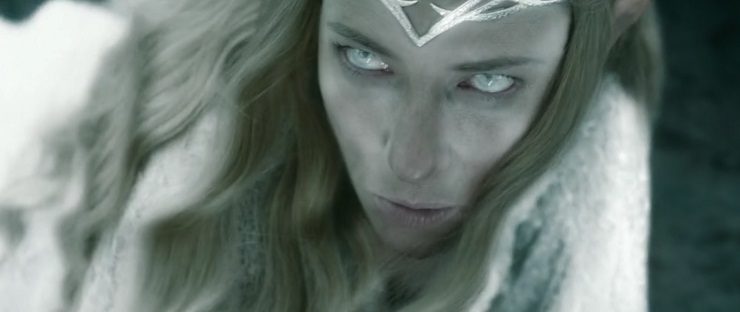
We know, of course, the part Galadriel plays on the Fellowship’s journey, when the One Ring is found and the Third Age draws toward its conclusion. We know of her fortune-telling Mirror (which just seems to magnify her already existing prescient wisdom), but it seems like her ability to read the minds of others is even more impressive:
‘I say to you, Frodo, that even as I speak to you, I perceive the Dark Lord and know his mind, or all of his mind that concerns the Elves. And he gropes ever to see me and my thought. But still the door is closed!’
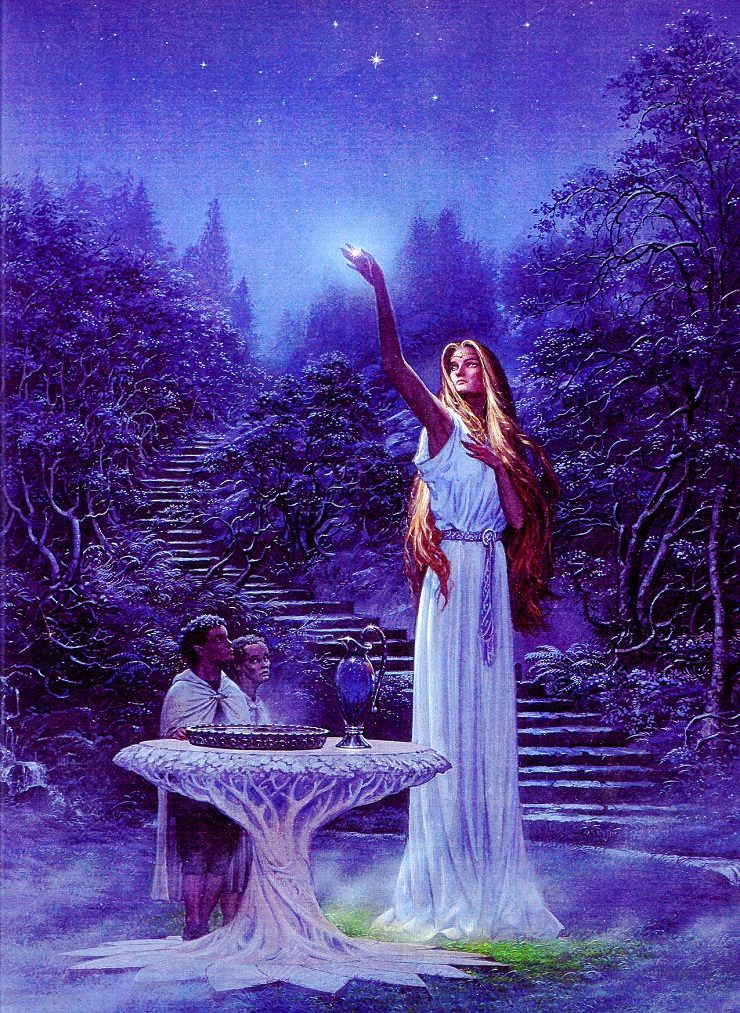
Sauron indeed seeks her, because she represents what he’s hated the most since Morgoth’s removal: those damned Elves holding out, still frustrating his ambitions and keeping him from total dominion.
We know also how Frodo offers her the One Ring—honestly, innocently, almost desperate to be unburdened by it—and that after a brief, yup-I-sure-have-seen-the-light-of-the-Trees Calaquendi moment, she declines it politely and with good humor. Of course, she knows very well what the One Ring could give her, and make of her. Talk about ruling a “realm at her own will,” Galadriel could rule all realms, depose the Dark Lord and be the ultimate Dark Queen. It’s clear she’s already given this a lot of thought. She’s had the time, and it seems like she’s already concluded how such an offer will go. Power is not actually what she wants anymore, and so her answer to Frodo is quick.
She knows that even in the best case scenario, if the One Ring is destroyed, then the power of her own ring will be extinguished, as will her entire purpose for remaining on Middle-earth. Is it a moment of fear, or elation for her? Probably both. When she says “I pass the test” to Frodo, it always reads to me like a private, quietly-to-herself sort statement. Or like one of those Shakespearean moments that can be interpreted and portrayed a thousand different ways.
‘I will diminish, and go into the West, and remain Galadriel.’
And when she says this I always feel like Sam and Frodo scarcely know what she’s talking about. But if you know her history, her choices, her exile, her pardon, her continued exile, then you do. If she goes into the West, to the Blessed Realm, she may be reunited with her lost kin, even those who died! She will just be Galadriel. A daughter, a sister, a mother. After all the time and effort and suffering she’s given of herself… well, that’s enough.
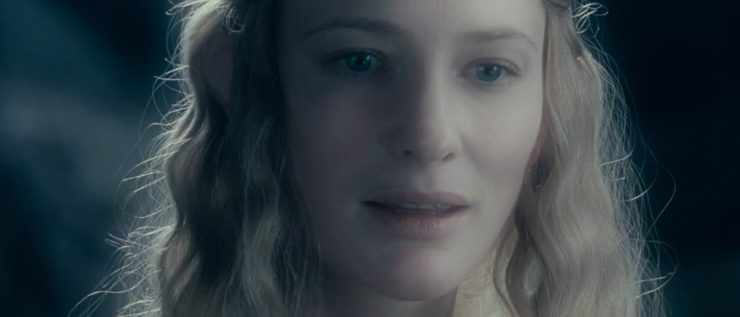
In some accounts of her history, Galadriel is actually still under a ban, for being complicit in rebellion and then for refusing the pardon, and is unable to return to Valinor even if she wants. But only up until this moment. Her refusal to take the One Ring, though it is offered freely (and would absolutely be within her power to simply take), grants her the Valar’s absolute pardon.
Before the final sendoff, Galadriel also gives Aragorn the Elessar as a token of her approval for his destiny. Not only as the future King of Gondor but also as the soon-to-be husband of Arwen (her granddaughter). The Elfstone should have been given to him by Celebrían, as part of a customary Elven bridal gift, but Celebrían is long since gone by now. And honestly, coming from Galadriel it is more fitting. She has overseen so many of the great events of the world—why not also the moment when the Fourth Age is dawning and the Age of Men has come?
Even when the Fellowship departs, her part is not yet over. She possesses an authority we don’t see in anyone else. Consider the great Eagles of Manwë, who nobody—but nobody—gets to command. They do favors when it suits them, when they’re nearby and not feeling especially cranky, or when the Valar specifically send them to intervene. Yet Galadriel does call on Gwaihir the Windlord directly—a very old bird, by one account hailing from the First Age himself!—and so he fetches Gandalf from a snowy peak in the Misty Mountains after his moment of rebirth. Gwaihir does this specifically at Galadriel’s “command” (his word, not mine!)… almost like she still has a bit of pull with the Valar. Who can say? At this point in the story, all the powers that have long been dormant seem to be stirring again. And it is because of Galadriel’s behind-the-scenes intervention that Gandalf is able to rejoin the scattered Fellowship and rally the captains of Men to later victory. Gandalf is the one we see riding to the rescue, but it is the Lady of Lórien who makes it possible for him to do so.
To me, Galadriel is the ultimate holdout of her kind. She is like the keeper of a lighthouse, or as a torchbearer in times of darkness. She makes it her job to keep hope alive when so much has been lost or faded away, especially in the Third Age when the Valar are more absent than ever and few remember them at all. The giving of her phial to Frodo for “when all other lights go out” is the perfect metaphor for her character. She weathers the joys and griefs of thousands of years but remains fair to others, like a kindly old woman who nurses a lifetime of hurts but still manages to smile reassuringly for young people and give them candy.
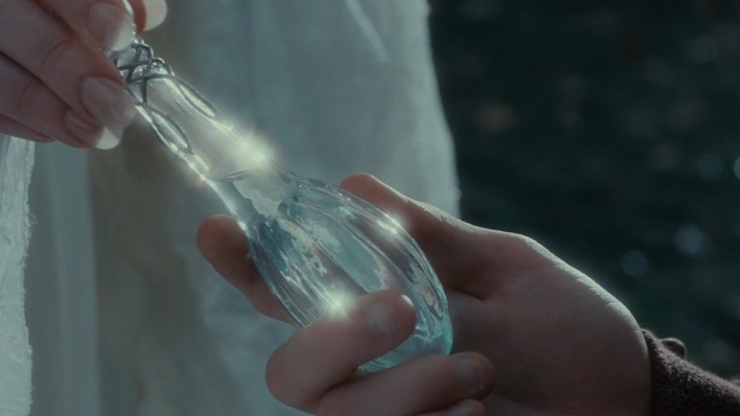
Her last words to Frodo when the Fellowship is leaving Lothlórien are “Remember Galadriel and her Mirror!” Her vendetta against Sauron by this point feels so personal, you almost wish she would have tossed out an edgier line, like: “When you see the Dark Lord, tell him Galadriel says, ‘Checkmate, bitch!’” Except, you know, something classier and more Tolkienesque.
When Sauron is at last defeated, Celeborn leads the Lórien Elves against the dreadful fortress of Dol Guldur (Sauron’s hidey-hole before revealing himself in the War of the Ring), and in the Appendices of The Lord of the Rings we are told that she “threw down its walls and laid bare its pits.” This language actually echoes the moment in The Silmarillion when Lúthien—Melian’s daughter, who Galadriel would have known well—came forth against a different Sauron-occupied fortress.
Lúthien stood upon the bridge, and declared her power: and the spell was loosed that bound stone to stone, and the gates were thrown down, and the walls opened, and the pits laid bare.
In any case, that’s the sort of First Age smackdown I would have loved to read more about with Galadriel. But that wasn’t always Tolkien’s vision for her, and to him Galadriel remains primarily a stately figure of power in reserve. A source of healing, comfort, and wisdom. But she has a long history, after all, and a complicated one. Her story, as Tolkien conceived it, was never fully pieced together; consequently, you’ve got different versions going on, and frankly, it’s fantastic that Christopher Tolkien was able to share them with us at all. But even when they contradict one another in the details, they all speak to the same sort of character.
Galadriel was once one of the leaders in a great, if misguided, rebellion. Then when the common evil was defeated but not exactly wiped clean, she remained when most of the other rebels departed, and so went on to become a leader in the organized resistance of the next great enemy. When you make these connections and are able to see her in this light, suddenly this white-clad princess begins to seem even more familiar to our pop culture sensibilities…
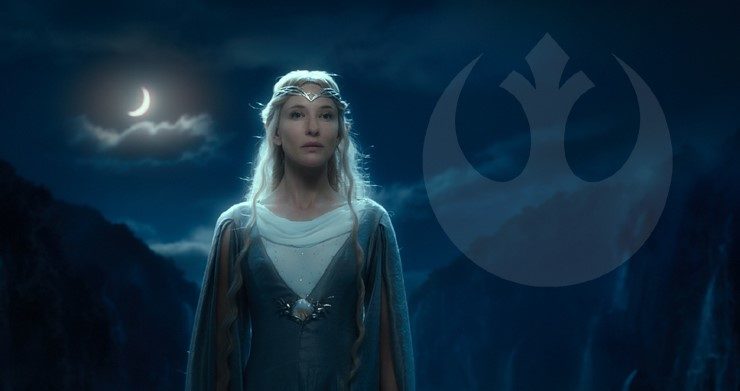
Jeff LaSala can’t leave Middle-earth well enough alone and is trying to figure out a surrepticious yet surefire way to make a future Lord of the Rings fan out of his 4-year-old son. Tolkien fandom aside, he also wrote some D&D books, orchestrated a cyberpunk anthology, and now works for Tor Books. And sometimes is on Twitter.










